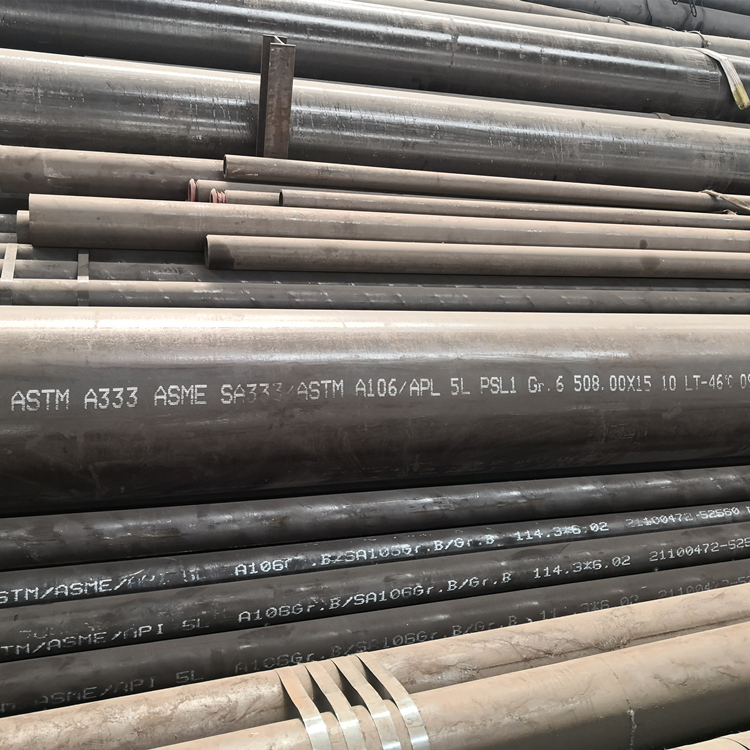ASTM A333 Gr6 seamless steel pipe for low-temperature pipelines
ASTM A333 Gr6 low-temperature pipe is an industrial pipeline suitable for seamless steel pipes used in low-temperature pressure vessel pipelines and low-temperature heat exchanger pipelines ranging from -45 ℃ to -195 ℃.
Spot specifications: 8-1240 × 1-200mm<1/8 “-48” × SCH5S – SCH160 STD、XS、XXS>
Execution standards: GB/T18984-2003、ASTM A333
Product Material: 16MnDG Low Temperature Tube, 10MnDG Low Temperature Tube, 09DG Low Temperature Tube, 09Mn2VDG Low Temperature Tube, 06Ni3MoDG Low Temperature Tube
ASTM A333Gr1 low-temperature tube, A333Gr3 low-temperature tube, A333Gr4 low-temperature tube, A333Gr6 low-temperature tube, A333Gr7 low-temperature tube, A333G8 low-temperature tube, A333Gr9 low-temperature tube
A333Gr10 low-temperature tube, A333Gr11 low-temperature tube
Product application: Suitable for seamless steel pipes for low-temperature pressure vessel pipelines and low-temperature heat exchanger pipelines ranging from -45 ℃ to -195 ℃
ASTM A333 Gr6 Impact Temperature of Seamless Steel Pipe for Low Temperature Service
| level | Minimum impact test temperature | – |
| ℉ | ℃ | – |
| 16MnDG | — | -45 |
| 10MnDG | — | -45 |
| 09DG | — | -45 |
| 09Mn2VDG | — | -70 |
| 06Ni3MoDG | — | -100 |
| A333 Gr1 | -50 | -45 |
| A333 Gr3 | -150 | -100 |
| A333 Gr4 | -150 | -100 |
| A333 Gr6 | -50 | -45 |
| A333 Gr7 | -100 | -75 |
| A333 Gr8 | -320 | -195 |
| A333 Gr9 | -100 | -75 |
| A333 Gr10 | -75 | -60 |
| A333 Gr11 | — | — |
Mechanical Properties of ASTM A333 Gr6 Seamless Steel Pipe for Low Temperature Service
| standard | brand | tensile strength(Mpa) | yield strength(Mpa) | Elongation rate(%) | – |
| longitudinal | horizontal | – | – | – | – |
| GB/T1898-2003 | 16MnDG | 490-665 | ≥325 | ≥30 | — |
| 10MnDG | ≥400 | ≥240 | ≥35 | — | – |
| 09DG | ≥385 | ≥210 | ≥35 | — | – |
| 09Mn2VDG | ≥450 | ≥300 | ≥30 | — | – |
| 06Ni3MoDG | ≥455 | ≥250 | ≥30 | — | – |
| ASTM A333 | A333Gr1 | ≥380 | ≥205 | ≥35 | ≥25 |
| A333Gr3 | ≥450 | ≥240 | ≥30 | ≥20 | – |
| A333Gr4 | ≥415 | ≥240 | ≥30 | ≥16.5 | – |
| A333Gr6 | ≥415 | ≥240 | ≥30 | ≥16.5 | – |
| A333Gr7 | ≥450 | ≥240 | ≥30 | ≥22 | – |
| A333Gr8 | ≥690 | ≥515 | ≥22 | — | – |
| A333Gr9 | ≥435 | ≥315 | ≥28 | — | – |
| A333Gr10 | ≥550 | ≥450 | ≥22 | — | – |
| A333Gr11 | ≥450 | ≥240 | ≥18 | — | – |

ASTM A333 Gr6 seamless steel pipe manufacturer production process control for low-temperature pipelines
Low temperature seamless steel pipes are mainly used in the production of ethylene, polypropylene, synthetic ammonia, LPG, as well as in the manufacturing of cryogenic equipment, ultra-low temperature cold storage, and the transportation of ultra-low temperature liquefied gas pipelines in the petrochemical industry.
Since 2016, the ASTM A 333/A 333M standard has made significant adjustments to the chemical composition of GR.6 low-temperature steel. On the basis of retaining the conventional five elements and their contents, Cr, Ni, Mo, Cu, V, Nb and other elements have been added, and the content limits of the newly added elements have been given. In other words, the C-Mn low-temperature steel A333GR.6, which we used to believe, has been upgraded to a low-temperature steel of low alloy steel.
(1) C element
The C element can form interstitial solid solutions in steel, and the diffusion or segregation of carbon atoms during heat treatment has a significant impact on the formation and distribution of carbides and the properties of steel. Carbide is a hard phase that can improve the strength, hardness, and wear resistance of steel, but it is not conducive to the improvement of steel toughness, and the carbon content should be minimized as much as possible;
(2) Si and Mn elements
Si is used in the steel smelting process to remove oxygen from the steel, which helps to enhance the high-temperature deoxidation and acid corrosion resistance of the steel; Mn is a strengthening element that can improve the hardness and wear resistance of steel, as well as reverse the stability of austenite. However, Mn is prone to form MnS inclusions with S, which can have a detrimental effect on the properties of steel;
(3) S and P elements
From the perspective of the effect of elements on low-temperature toughness, it is generally believed that C, Si, P, S, N, etc. are harmful elements, with P being the most harmful, while Mn, Ni, etc. are beneficial elements. Therefore, ASTM A 333/A333M-2013 mainly relies on Mn to improve the low-temperature performance of Gr6, and strictly controls the S and P content.
(4) Ni element
Ni is an alloy element that promotes the stable existence of austenite, which is beneficial for improving the plasticity and strength of steel, while reducing the brittle hard transition temperature of steel. Nickel rich reverse austenite can be stored stably under extremely low temperature conditions, which has an important impact on the improvement of low-temperature toughness of A333Gr6. The A333GR. 6 version after 2016 has further enhanced its low-temperature performance with the addition of Ni and alloying effects such as V and Nb.
In the supply state, A333GR.6 seamless steel pipe underwent microstructure inspection, and the inspection results showed that the Gr6 metallographic structure is ferrite+pearlite, with uniform microstructure and grain size of 7-9 levels, which lays the organizational foundation for good low-temperature toughness. Metallographic morphology of Gr6 seamless steel pipe for low yield to strength ratio low-temperature pipelines. As shown in the following figure. Without affecting the low-temperature impact toughness, the coarser the ferrite grain size, the lower the yield to strength ratio of the microstructure.
A333GR. 6 heat treatment
Heat treatment can improve the microstructure and grain size of A333GR.6 low-temperature tubes. The original state of A333Gr6 low-temperature tube is coarse-grained ferrite+pearlite, with uneven tissue distribution and poor impact resistance under low-temperature conditions. The tempered martensite structure with martensitic morphology features has a more uniform grain size and microstructure, good conventional mechanical properties, and significantly improved low-temperature impact toughness. The heat treatment for the general A333GR. 6 supply state is heating to a temperature not lower than 1500F ° C (815 ° C), quenching in liquid, and then reheating to an appropriate tempering temperature to control its microstructure and improve low-temperature toughness.








